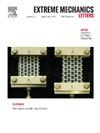Fresh considerations regarding time-dependent elastomeric fracture
IF 4.3
3区 工程技术
Q2 MATERIALS SCIENCE, MULTIDISCIPLINARY
引用次数: 0
Abstract
The fracture behavior of polymers in elastomeric state exhibits rich characteristics. Stretch rate and temperature can independently, as well as in combination, influence how such polymeric networks resist crack initiation and propagation. The strong rate and temperature dependencies of tensile strength and toughness in absence of high viscoelasticity, previously shown to occur in Rubber Chem&Tech 96, 530, 2023 and plausibly in J. Polym. Sci. 18, 189, 1955 and 32, 99, 1958 are also observed in rate-sensitive elastomers. This work aims to propose, at a conceptual level, a general understanding of elastomeric fracture by addressing the considerable confusion surrounding the relationship between crack growth rate (vc) and Griffth-Irwin's energy release rate (Gc) in different elastomeric systems. Our fracture tests demonstrate that (a) crack propagation velocity vc varies with the applied loading level produced by either stepwise or continuous stretching, (b) emergent entanglement effectively modifies network structure and the relationship between vc and Gc, and (c) temperature T affects vc at a given load. We conclude that the magnitude of imposed strain, from which Gc may be evaluated, prescribes the level of bond tension in load-bearing network strands and dictates bond dissociation kinetics. Consequently, crack growth rate depends explicitly on loading level (e.g., Gc) and temperature. In the relationship between vc and Gc, vc is the effect and Gc is the cause, contrary to the previous viewpoint.
求助全文
约1分钟内获得全文
求助全文
来源期刊

Extreme Mechanics Letters
Engineering-Mechanics of Materials
CiteScore
9.20
自引率
4.30%
发文量
179
审稿时长
45 days
期刊介绍:
Extreme Mechanics Letters (EML) enables rapid communication of research that highlights the role of mechanics in multi-disciplinary areas across materials science, physics, chemistry, biology, medicine and engineering. Emphasis is on the impact, depth and originality of new concepts, methods and observations at the forefront of applied sciences.
 求助内容:
求助内容: 应助结果提醒方式:
应助结果提醒方式:


